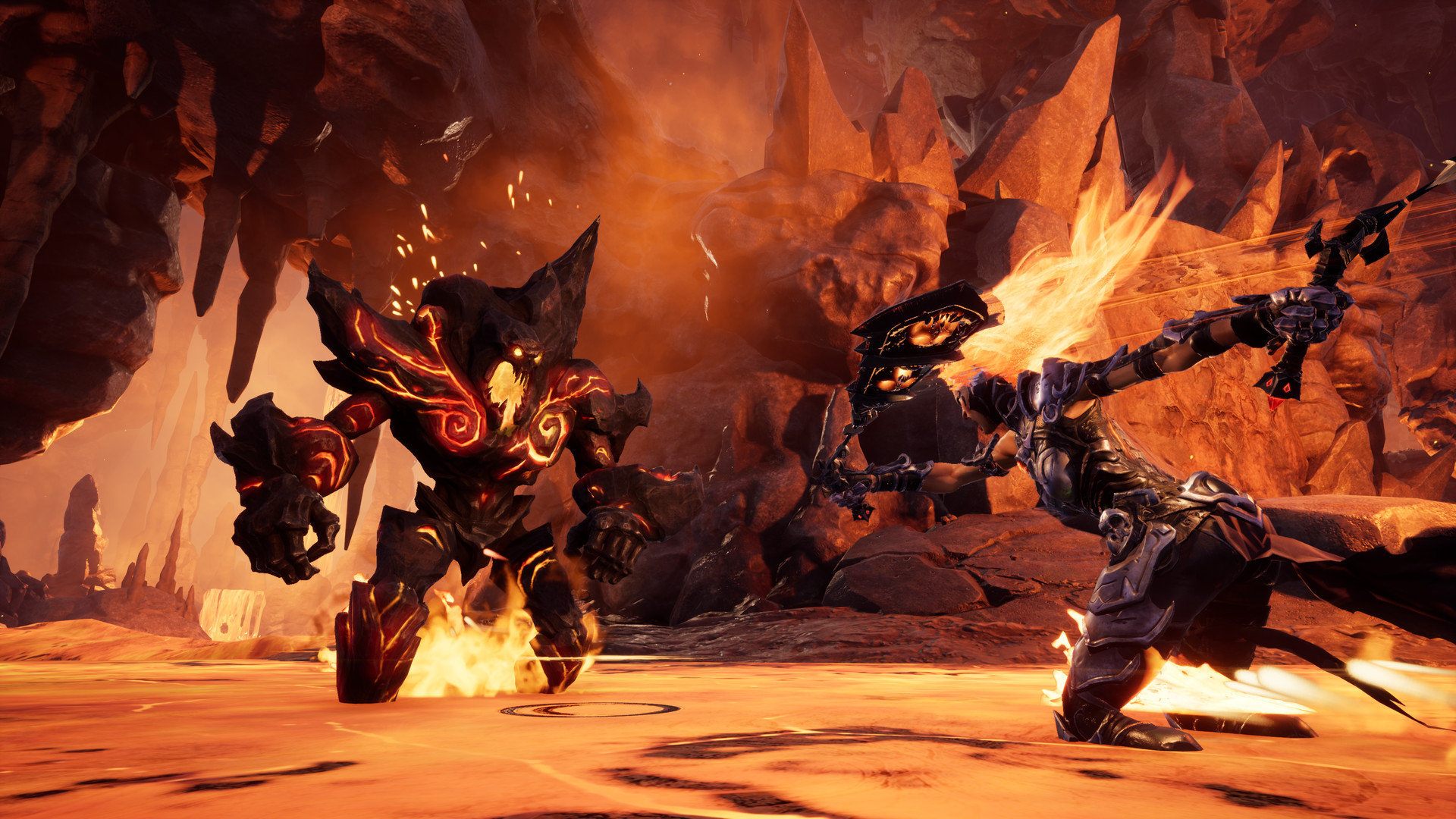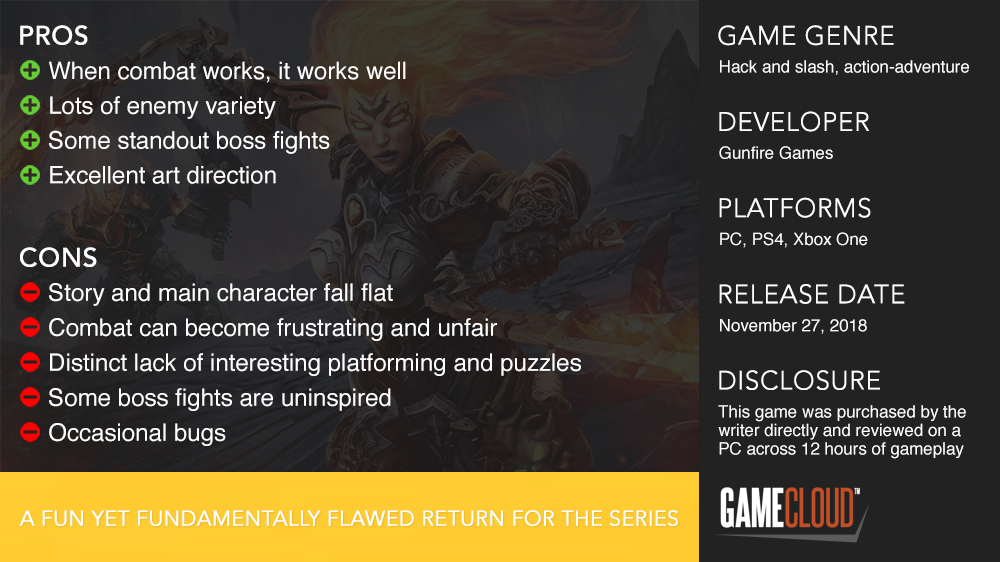
When a game franchise goes cold for six long years, it’s safe to assume that it won’t be coming back. Couple this with the collapse of THQ, and it seemed that Darksiders was doomed to be a half-finished tetralogy despite its relative success and widespread following. It should come as no surprise then that the return of Darksiders was an unorthodox announcement from THQ Nordic, with a third entry being helmed by Gunfire Games, who assisted in the development of Darksiders II. Fans were naturally cautious and for good reason as early alpha footage didn’t look particularly promising, but I was still drawn to Darksiders III because of where it takes inspiration from with its world design and combat.

Continuing the series’ tradition, Darksiders III features Fury, one of the four horsemen of the apocalypse as the main protagonist. She’s far more cocky and violent than her brothers, which is made apparent from the first cutscene. Fury is tasked by the Charred Council to hunt down the recently released Seven Deadly Sins. During this journey, she questions higher powers, seeks to improve her weaknesses, and ultimately bring balance back to the world. There isn’t much character development going on within this title, and what little does transpire feels ineffective and rushed. It doesn’t help when moments are meant to tug at my heartstrings failed, and it all comes together in a way that leaves Darksiders III feeling a little flat in the grand scheme of things. There are a few opportunities to mildly affect how the ending plays out, but it’s nothing that alters a conclusion which is clearly a setup for a fourth entry.
Anyone can see by watching some gameplay how heavily this title leans into design elements from Dark Souls. Comparisons are unavoidable and for good reason. You level up Fury and her stats by feeding souls to an NPC, enemies hit hard, dodging is paramount to victory, healing is strictly limited to a flask that holds charges, and other crystals that can be found in the overworld. It still retains some of the dungeon design philosophy and puzzles found in Darksiders I and II but to a much smaller extent. The result is a bit of a mixed bag that fans might not agree with, but there’s a lot of positive improvements too.

Trying to capitalise off the success of Dark Souls is like dancing on thin ice. The fine-tuning and balancing of enemy encounters to keep everything fair and square difficulty wise is something FromSoftware haven’t pulled of flawlessly in their games yet, and Gunfire Games doesn’t succeed either. It’s hard not to feel cheated when you perfectly dodge a blow, but another one hits you before you can even input another dodge. It’s a frequent occurrence that makes engaging with enemies far more frustrating than it needs to be, and I just found myself getting impatient with the game as a result.
When combat works, though, it works. Fury’s whip is one of, if not the best designed whip-based weapons I’ve used in a video game yet. It’s satisfyingly brutal with its metallic cracks and whirs. There are no unlockable combos or additional moves for the gear that you have, but a distinct array of four secondary weapons keep combat from feeling stale in the long run. Each has their special moves, and Arcane Counters, which can be performed for a significant chunk of damage after a successful dodge. A large variety of enemy types are slowly introduced as you traverse through new environments, keeping you on your toes and ensuring a constant challenge. It all comes together nicely in most of the boss fights with the Seven Deadly Sins. I say most because they vastly vary in quality. Some have minor puzzle elements like boss fights of past games, but most of them are dodge, attack, and repeat.

The platforming and puzzle-ridden dungeons are also in low supply in favour of a more combat orientated experience. I rarely found myself stumped by what few were in the game, but the solutions couldn’t help but leave me feeling as if they could’ve been something more. Fury’s abilities are used in unique ways that solve typical problems found within video game dungeons, but it’s never explored to an extent that makes them memorable. Platforming is also more infrequent than it was, and usually only consists of timing jumps and whip swings in a particular manner. These are two core gameplay elements of the series that have been built on meaningfully across Darksiders I and II, but only tease their potential in Darksiders III.
Darksiders has always had an incredible visual style. There’s a sense of wonder and awe contained within the apocalyptic settings of these games, and Gunfire Games have carried on that tradition with open arms. I love the look of Darksiders III. It’s fully realised environments are grand in size and scale, filled to the brim with vibrant colours and immaculate character designs. It’s hard not to admire Fury’s wonderfully animated hair as it flickers between light blue, red, purple and more as you change secondary weapons. The game ran nicely alongside this, but I did experience a few bugs that hindered my enjoyment, like Fury getting stuck in a rock, or AI just standing there waiting to be attacked.

Darksiders III is a fundamentally flawed title that does away with numerous systems and mechanics that the past two titles had iterated and built upon in meaningful ways, but it also allows for a new type of entry in the series as a result. I had way more fun with it than I expected to, but I also can’t recommend it to fans of the series who were looking for more of the same, because they simply won’t get it here. Darksiders III fails to translate the scale of the events transpiring within the franchise’s universe in favour of a more contained narrative that falls flat alongside its boring protagonist. However, if you enjoy Dark Souls, I’d urge you to at least give this title a shot. There’s plenty of fun to be had here if you can accept the game for the fun but flawed experience that it is.











